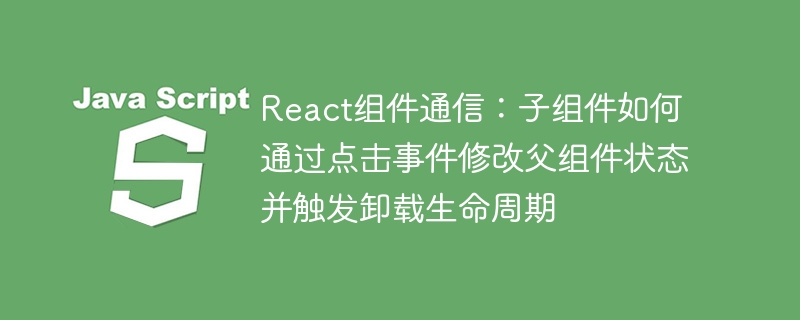子组件触发父组件状态更新与卸载流程
时间:2025-08-23 14:06:31 445浏览 收藏
哈喽!今天心血来潮给大家带来了《子组件触发父组件状态更新与卸载流程》,想必大家应该对文章都不陌生吧,那么阅读本文就都不会很困难,以下内容主要涉及到,若是你正在学习文章,千万别错过这篇文章~希望能帮助到你!

1. React组件间的数据流与状态提升
在React中,数据流通常是单向的,即从父组件流向子组件。然而,在实际应用中,子组件经常需要通知父组件某些事件的发生,并可能导致父组件状态的改变。解决这一问题的常用模式是“状态提升”(Lifting State Up),即父组件定义状态以及修改该状态的方法,然后将修改方法作为props传递给子组件。子组件在需要时调用这个props函数,从而间接修改父组件的状态。
2. 子组件触发父组件状态更新的实现机制
要实现子组件通过点击事件修改父组件状态,核心步骤如下:
- 父组件定义状态和更新函数: 父组件维护一个需要被子组件影响的状态,并定义一个方法来更新这个状态。
- 将更新函数作为props传递: 父组件在渲染子组件时,将上述更新函数作为props传递给子组件。
- 子组件调用props函数: 子组件在事件(如点击事件)发生时,调用通过props接收到的函数。
下面是一个基础的示例结构:
// 父组件 (App.js)
import React from 'react';
import ChildComponent from './ChildComponent';
class App extends React.Component {
constructor(props) {
super(props);
this.state = {
displayChild: true
};
this.toggleDisplay = this.toggleDisplay.bind(this); // 绑定this
}
toggleDisplay() {
this.setState(prevState => ({
displayChild: !prevState.displayChild
}));
}
render() {
return (
<div>
{this.state.displayChild && <ChildComponent onToggle={this.toggleDisplay} />}
{!this.state.displayChild && <p>Child component is hidden.</p>}
</div>
);
}
}
// 子组件 (ChildComponent.js)
import React from 'react';
class ChildComponent extends React.Component {
componentDidMount() {
console.log("ChildComponent mounted!");
}
componentWillUnmount() {
console.log("ChildComponent will unmount!");
// 在这里执行清理操作,例如清除定时器、取消网络请求等
}
render() {
return (
<div>
<h1>This content is shown!</h1>
<button onClick={this.props.onToggle}>
Toggle View
</button>
</div>
);
}
}
export default App;在上述代码中,App组件通过this.state.displayChild控制ChildComponent的显示与隐藏。toggleDisplay方法被作为onToggle属性传递给ChildComponent。当ChildComponent中的按钮被点击时,它会调用this.props.onToggle,从而更新App组件的displayChild状态。
3. 常见错误与正确引用状态
在实现上述逻辑时,一个常见的错误是错误地引用父组件的状态。例如,在父组件的render方法中,如果错误地使用this.show而不是this.state.show来判断条件渲染,就会导致逻辑失效。
考虑以下有问题的代码片段:
// 错误的示例片段
class App extends React.Component {
constructor(props){
super(props);
this.state={
show:true
}
}
render() {
const toggleDisplay=()=>{
this.setState({show:!this.state.show});
}
return (
<div className="App">
{this.show && <ChildrenUnmounting onclickfun={toggleDisplay} />} {/* 错误:此处应为this.state.show */}
</div>
);
}
}在上述代码中,{this.show &&
正确的修改方案:
将App组件中的渲染逻辑更改为:
// 正确的示例片段
class App extends React.Component {
constructor(props){
super(props);
this.state={
show:true
}
this.toggleDisplay = this.toggleDisplay.bind(this); // 建议绑定
}
toggleDisplay(){ // 提取为类方法,避免每次渲染都创建新函数
this.setState(prevState => ({show:!prevState.show}));
}
render() {
return (
<div className="App">
{this.state.show && <ChildrenUnmounting onclickfun={this.toggleDisplay} />} {/* 正确:使用this.state.show */}
</div>
);
}
}
class ChildrenUnmounting extends React.Component {
// 构造函数中无需将props复制到state,直接使用this.props.onclickfun
// constructor(props) {
// super(props);
// }
render() {
return (
<>
<h1>This content is shown!</h1>
<button onClick={this.props.onclickfun}> {/* 直接使用props */}
Toggle View
</button>
</>
);
}
componentWillUnmount() {
console.log("componentWillUnmount is called!");
// 在此执行资源清理
}
}通过将{this.show && ...}修正为{this.state.show && ...},父组件将正确地根据其show状态来决定是否渲染ChildrenUnmounting组件。当show状态从true变为false时,ChildrenUnmounting组件将被从DOM中移除,从而触发其componentWillUnmount生命周期方法。
4. 理解componentWillUnmount生命周期方法
componentWillUnmount是React类组件的一个生命周期方法,它在组件即将被卸载和销毁之前被调用。这个方法是执行任何必要的清理操作的理想场所,例如:
- 清除定时器或延时器: 如果组件内部设置了setTimeout或setInterval,需要在组件卸载前清除它们,以避免内存泄漏或不必要的行为。
- 取消网络请求: 如果组件发起了异步网络请求,但在请求完成前组件被卸载,应取消该请求以避免在已卸载组件上调用setState。
- 移除事件监听器: 如果组件在componentDidMount中添加了全局事件监听器(如window.addEventListener),则应在componentWillUnmount中移除它们。
在上述示例中,当App组件的show状态变为false时,ChildrenUnmounting组件不再被渲染,React会将其从DOM中移除。在移除之前,ChildrenUnmounting组件的componentWillUnmount方法会被调用,此时可以执行任何清理逻辑,例如示例中的console.log("componentWillUnmount is called!");。
5. 总结与最佳实践
- 状态提升是React组件通信的关键模式: 当子组件需要影响父组件的状态时,父组件应将状态更新函数作为props传递给子组件。
- 准确引用状态: 始终通过this.state.propertyName来访问组件的状态,而不是直接this.propertyName。
- 利用componentWillUnmount进行清理: 确保在组件卸载前执行必要的资源清理,防止内存泄漏和不必要的副作用。
- 函数式组件与Hooks: 对于现代React应用,推荐使用函数式组件和Hooks(如useState和useEffect)。useEffect Hook结合其返回的清理函数,可以优雅地处理组件的挂载和卸载逻辑,替代componentDidMount和componentWillUnmount。
通过遵循这些原则,开发者可以构建出健壮、可维护的React应用,有效管理组件间的数据流和生命周期。
理论要掌握,实操不能落!以上关于《子组件触发父组件状态更新与卸载流程》的详细介绍,大家都掌握了吧!如果想要继续提升自己的能力,那么就来关注golang学习网公众号吧!
-
502 收藏
-
501 收藏
-
501 收藏
-
501 收藏
-
501 收藏
-
486 收藏
-
303 收藏
-
322 收藏
-
449 收藏
-
212 收藏
-
492 收藏
-
474 收藏
-
459 收藏
-
387 收藏
-
337 收藏
-
396 收藏
-
174 收藏
-

- 前端进阶之JavaScript设计模式
- 设计模式是开发人员在软件开发过程中面临一般问题时的解决方案,代表了最佳的实践。本课程的主打内容包括JS常见设计模式以及具体应用场景,打造一站式知识长龙服务,适合有JS基础的同学学习。
- 立即学习 543次学习
-

- GO语言核心编程课程
- 本课程采用真实案例,全面具体可落地,从理论到实践,一步一步将GO核心编程技术、编程思想、底层实现融会贯通,使学习者贴近时代脉搏,做IT互联网时代的弄潮儿。
- 立即学习 516次学习
-

- 简单聊聊mysql8与网络通信
- 如有问题加微信:Le-studyg;在课程中,我们将首先介绍MySQL8的新特性,包括性能优化、安全增强、新数据类型等,帮助学生快速熟悉MySQL8的最新功能。接着,我们将深入解析MySQL的网络通信机制,包括协议、连接管理、数据传输等,让
- 立即学习 500次学习
-

- JavaScript正则表达式基础与实战
- 在任何一门编程语言中,正则表达式,都是一项重要的知识,它提供了高效的字符串匹配与捕获机制,可以极大的简化程序设计。
- 立即学习 487次学习
-

- 从零制作响应式网站—Grid布局
- 本系列教程将展示从零制作一个假想的网络科技公司官网,分为导航,轮播,关于我们,成功案例,服务流程,团队介绍,数据部分,公司动态,底部信息等内容区块。网站整体采用CSSGrid布局,支持响应式,有流畅过渡和展现动画。
- 立即学习 485次学习
